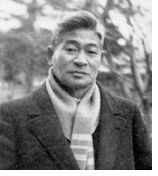

HISTORY OF HAIKU
10 haikuists and their works
Chapter 9
Suju Takano (1893 ~ 1976)
 The poets of Taisho Hototogisu had produced many masterpieces,
by resorting to romantic imagination and to the emphatic words. But this
tendency had gone to excess and haikus pursuing superficial effects became
popular.
The poets of Taisho Hototogisu had produced many masterpieces,
by resorting to romantic imagination and to the emphatic words. But this
tendency had gone to excess and haikus pursuing superficial effects became
popular.
At the beginning of the Showa era (1926 ~ 1989), the haikus of the Hototogisu school took a new direction; Kyoshi Takahama, to moderate this excess, started to advocate the necessity of "shasei" (sketching). This meant return to the design of Shiki Masaoka. He insisted that haikus not based on exact observation and precise description do not touch the readers. He invented the expression "kyakkan shasei" (objective sketching) and made it the principle of writing.
Following this new direction, several poets appeared such as Shuoshi Mizuhara (1892 ~ 1981), Suju Takano, Seiho Awano (1899 ~ 1992), Seishi Yamaguchi (1901 ~ 1994), Kusatao Nakamura (1901 ~ 1983). Each poet could create a personal style adapting "kyakkan shasei". I present here Suju Takano, who left the most remarkable poems.
An important characteristic of his haikus is the description of foreground. Often, his haikus contain only things right before the eyes. This method makes a sharp contrast with that of the Taisho Hototogisu poets who intended to describe the distant view especially. (see the article of Hisajo Sugita)
Shuoshi Mizuhara, opposed to Suju, severely reproached his descriptions of foreground which, Shuoshi said, were no more than monotonous scientific reports. But Shuoshi's criticism does not seem just to me. If we read Suju's haikus attentively, we realize that he keeps unique understanding of the structure of space in his expressions which look like, at first sight, simple explanations of landscape.
Almost all the haikuists regard the works of Suju as results of the "kyakkan shasei". However he was not a realistic artist in the modern sense of words. He respected symbolic nuances that words, especially kigos, contain. He adopted the attitude to project images of things on the screen made of nuances of the words.
Consequently, even if there are descriptions of foreground, Suju's haikus do not throw them into sharp relief; they give an impression that the poet carried his viewpoint far away and that he saw "here" in peace.
On the contrary, Kusatao Nakamura, contemporary of Suju, was a true realist; he liked to tear traditional nuances off the words.
Suju's works that use fully the symbolizing function of the Japanese
language, is one of the highest peaks of the Hototogisu school.
Doodlebugs.
Only the wind is heard
Blowing in the pines.
Sprout of plantain,
Three leaves
Of various sizes.
Line of licorice's sprouts
At intervals.
Towards the summer hill
He walks
In the garden.
Spring snow
Like waves
Climbs over the fence.
Evening hailstones
Beat branches.
Their whiteness.
This peach is green.
And it holds a little red.
One spider's thread
Stretched tight
In front of a lily.
Separately
Fly away over there
Crows of the New Year.
A bubble grows.
A thin ice plate moves a little.
Written by
Ryu Yotsuya
Next Page (Kakio Tomizawa)
HOME / Index
French / Japanese
e-mail to Ryu Yotsuya and Niji Fuyuno
loupe@big.or.jp